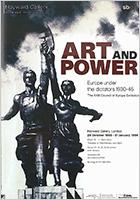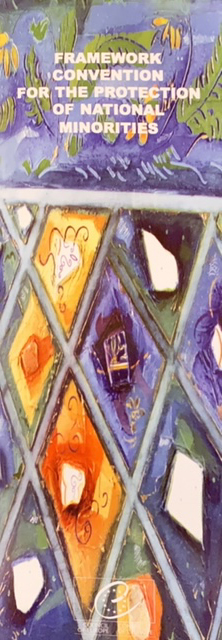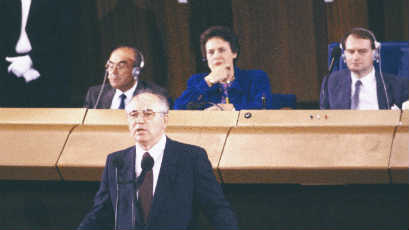Asset Publisher

Reviving Cultural life in Central and Eastern Europe after the fall of the Berlin Wall
1990-1995
David Mardell

It was not the first time that the question of culture had informed European politics. Even during the Cold War, European States, whether democratic or not, had found areas of congruence and common interest among them, thanks to the European Cultural Convention of 1954. As the Art Exhibitions also proved, the conviction that culture was the very foundation of Europe’s identity had enabled the Council, without in any way relinquishing its values, to eliminate whatever obstacles might impede communication between the peoples of this continent. The result was immediately evident within months after the fall of the Berlin Wall. From 1989 on, museums in some of the Soviet bloc countries began to co-operate and lend works from their collections to the Council of Europe exhibitions. And later on, after renouncing their faith in communism in the early 1990’s, the central and east European States immediately signed the Cultural Convention, which ratified this collaboration.
Following a proposal by the Group of Consultants on Art Exhibitions, a very moving and enlightening show was staged in 1995 and 1996. It was entitled ‘Art and Power – Europe under the dictators 1930-1954’ and it demonstrated the tremendous influence art and architecture could have on forging people’s minds and attitudes. This, moreover, was quickly followed by the 24th exhibition, “Der Traum vom Glück” which was on the theme of historicism – another potent influence on social and national sentiment in the population.
But more directly we, in the Secretariat, wanted to help all neighbouring countries in our expanded Europe with the task of retrieving their cultures; we hoped to provide all kinds of creative possibilities to artists in nations that had languished for years under dictatorships that were more interested in propaganda than in real art. Music, dance, theatre were obviously all challenging areas but what seemed most important to me in those days was the field of publishing. Books needed to liberated too after decades of censorship. Having been put in charge of the overall management of the project, I hoped to ensure that every one of those countries could control its own publications and be protected from the domination of big ‘outsiders’.
With the approval of the Council for Cultural Co-operation (CDCC), we first called upon a very competent organization in Britain, called “International Book Development” (IBD), which had already embarked upon an in-depth study of publishing in precisely those countries. After a first, very successful meeting with the CDCC, this organization drew up an exhaustive report on the subject, outlining in particular the immediate challenges faced by publishers in Central and Eastern 2 Europe. These included finance, of course, but also indicated the need for the training of publishers in the requisite skills related to the book trade.
As a result of this report, a plan was submitted to the Conference of European Ministers of Culture in 1992 and a new project was given to the Council of Europe. The very competent and experienced French specialist, Jean Gattégno, was put in charge and ran this project for several years before his premature death. He was afterwards replaced by Giuseppe Vitiello, another hardworking and brilliant colleague. Under this overall scheme of the Council of Europe, and with the help of member States, prospective publishers were given appropriate training in the basic arts of book publication in their countries. An ingenious system of financing was also put in place through which the profits made from revising new schoolbooks, which had previously inculcated a revisionist and highly selective version of history, became available for the purposes of translation and publication. These funds enabled seminal works of importance in Europe literature to reach the reading public in these countries, and ensured that national authors who had otherwise little hope of reaching beyond their borders, became known and appreciated abroad. One example of the former backlog might illustrate the lacunae in the publishing field: in 1992, so I was told by IBD, there had yet to be translations of Freud into Bulgarian…
Meanwhile cultural horizons were brightening everywhere in Europe; different States were all beginning to participate in the project, with multifarious assistance schemes. The only problem was one of organization. In our discussions with colleagues from the Eastern and Central European countries, we learned that they were often being proposed exactly the same training courses by three or more countries, and were sometimes too discreet to refuse. So we decided to convene a meeting of international organizations and those in charge of assistance programmes in all member States to study the logistics of the program and avoid duplication of effort and resources. As a result, a list of agreements was drawn up regarding who was to propose what, and who was to receive how much in the cultural domain. In spite of the challenging nature of these questions, the exchange was such a success that by the close of the meeting, we had miraculously covered and agreed on all the issues before us!
At that point, I suggested that, unless a real need arose in the future, we would not have to convene again. The representative of UNESCO who was present at the meeting, came to me afterwards and said that it was the first time, in all his years, that he had ever witnessed an international civil servant proposing not to convene more meetings! Our success had led to “bureaucratic suicide” in effect! It may have been a Council of Europe “first”, but was proof that our ideal could be to succeed so well as to make ourselves redundant.
Once the Book Project was underway, we turned our attention to another area in dire need of support, namely the visual arts. In those former communist countries, artists could no longer count on public commissions for their work and practically none of the galleries were contracting art works. So with a rather modest budget we managed to send two experts – Jean-Yves Bainier, the Director of Visual Arts at the Direction Régionale des Affaires Culturelles in Strasbourg, and Dimitri Konstantinidis, the Director of the FRAC (Fonds Régional d’Art Contemporain) in Sélestat - to a dozen or so Central and East European countries on a mission to this end.
Their first mandate was to spot promising artists and their second was to help bring them into the prosperous art fairs in the west. A catalogue was produced, which though incomplete, was at least a start, and quite a number of artists, who have since become prominent in Europe, were given their first chance this way. Later on, the Council managed to convince art galleries, which took part in art-fairs like Basle or St’art, to reserve a place on their stands for budding galleries from the East as well. Many generously participated, and as a result, we also managed to put on a few exhibitions of 3 western contemporary art in central European countries, notably by using the collections of the French FRAC’s.
The project was intended to expand gradually and an association independent of the Council, called Apollonia, was set up to further promote this kind of co-operation in contemporary art between East and West. Unfortunately, the Council stopped its financial support to Apollonia the month after I retired, but the association still exists in Strasbourg with its headquarters and an exhibition gallery close by the Council. Moreover, it is recognized and strongly backed by the European Union, which has given it three times its competitive triennial funding, amounting to several million euros. Nowadays, it runs a wide series of exchanges involving numerous artists who are given residences in impoverished areas, both in the east and the west, and its aim is to bring artistic creation closer to those who would otherwise be excluded from this domain. The project also encourages and helps such populations to become involved in urban planning in order to enhance the cultural environment where they live. This has become a very practical and efficient endeavour that will no doubt last a long time.
But Apollonia has never forgotten its beginnings within the Council of Europe. The questions which the Council first raised in embarking on its cultural adventure in eastern and central Europe are still of concern across the continent. The possibility of cultural as well as political unity in Europe is still one of the fundamental challenges of our times. The task of reviving the cultures as well as the economies of the member States still remains, like a tantalising vision, before us. Perhaps by helping European countries further expand their horizons, through translations, publications, exhibitions and cultural collaboration, we might avoid future wars, including cold ones.



